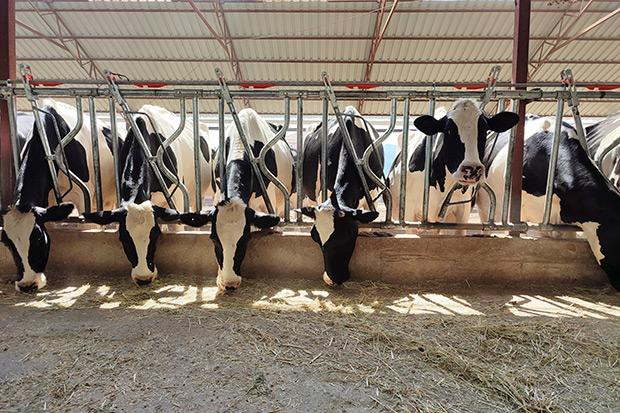More dairy cattle in Idaho, New Mexico, and Texas have tested positive for highly pathogenic avian influenza virus (HPAI).
The U.S. Department of Agriculture (USDA) Animal and Plant Health Inspection Service (APHIS) announced April 1 and 2 that these mark the first known cases of HPAI in cattle in Idaho and New Mexico, and add to the two detections in Texas and two in Kansas that were announced on March 25.
To date, the USDA has confirmed the detection of HPAI in seven dairy herds in Texas, two in Kansas, and one each in Idaho, Michigan, and New Mexico. The National Veterinary Services Laboratories (NVSL) is currently performing confirmatory tests on presumptive positive results from Kansas, New Mexico, Ohio, and Texas. While these samples are from cattle with at least some clinical signs in common with other cattle diagnosed with HPAI, the USDA says the presence of HPAI should not be considered confirmed until the NVSL analysis is complete.

The NVSL has also confirmed that the H5N1 strain of the virus found in subsequent states is very similar to the strain originally confirmed in cattle in Texas and Kansas that appears to have been introduced by wild birds.
The Michigan dairy herd had recently received cows from Texas, according to the USDA.
And the Idaho State Department of Agriculture announced March 28 that it had identified its first cases of HPAI in a Cassia County dairy cattle operation. The affected facility recently imported cattle from another state that had previously identified cases of HPAI in cattle.
In New Mexico, the Alamogordo Daily News reported earlier that there have been cases of HPAI infection in cattle in Curry County, citing a statement from U.S. Senator Martin Heinrich’s office.
Human case of HPAI
Additionally, HPAI infection has been confirmed in one person with known exposure to Texas dairy cattle presumed to be infected with the virus, the Centers for Disease Control and Prevention (CDC) announced April 1. Eye redness—consistent with conjunctivitis—is their only symptom. The patient was told to isolate and is receiving an antiviral for flu.
This is the second person reported to have tested positive for influenza A (H5N1) viruses in the United States, the CDC said. A previous human case occurred in 2022 in Colorado. Human infections with avian influenza A viruses, including A (H5N1) viruses, are uncommon but have occurred sporadically worldwide.
The agency has been monitoring for illness among people exposed to H5 virus-infected birds since outbreaks were first detected in U.S. wild birds and poultry in late 2021. Human illnesses with H5N1 bird flu have ranged from mild, such as eye infection and upper respiratory symptoms, to severe illness, such as pneumonia, that have resulted in death in other countries.
The CDC also stated in its announcement that this infection does not change the health risk assessment for the U.S. general public, which CDC considers to be low. However, people with close or prolonged, unprotected exposures to infected birds or other animals, or to environments contaminated by infected birds or other animals are at greater risk of infection. The CDC has interim recommendations for prevention, monitoring, and public health investigations of HPAI viruses.
Several strains of the HPAI virus have been spreading among wild birds, commercial poultry, and a growing number of mammals in the United States since January 2022 in what is being described as the largest epizootic of HPAI in the nation’s history.
Initial testing by the USDA’s NVSL has not found changes to HPAI virus that would make it more transmissible to humans. Spread of clinical signs among the Michigan herd indicates that HPAI transmission between cattle cannot be ruled out, the announcement said.
Common clinical signs in affected cows have been reduced milk production and low appetite. Affected animals have recovered after isolation with little to no associated mortality reported, according to the USDA. Veterinarians and producers are urged to practice good biosecurity, minimize animal movements, test animals before necessary movements, and isolate sick cattle.
Milk supply safety
The USDA, along with the Food and Drug Administration (FDA) and the CDC, say they have no concerns about the safety of the commercial milk supply because milk from impacted animals is being diverted or destroyed so it does not enter the human food supply. Pasteurization inactivates bacteria and viruses, like influenza, in milk, and is required for milk entering interstate commerce for human consumption.
The FDA strongly encourages that any milk diverted for feeding calves be heat treated to kill harmful bacteria or viruses before feeding. The agency also recommends that the dairy industry refrain from selling raw milk or raw and unpasteurized cheese products made from milk from cows showing signs of illness. People are advised not to drink raw milk or eat raw milk–based cheese.
“FDA’s longstanding position is that unpasteurized, raw milk can harbor dangerous microorganisms that can pose serious health risks to consumers, and FDA is reminding consumers of the risks associated with raw milk consumption in light of the HPAI detections,” the USDA announcement said. The AVMA echoes these concerns in its policy on “Raw Milk.”
Milk loss resulting from affected cattle to date is too limited to have a major impact on the price of milk or other dairy products, according to the USDA. Further, the U.S. typically has a more than sufficient milk supply in the spring months due to seasonally higher production.
Federal agencies are also working with state and industry partners to encourage farmers and veterinarians to report cattle illnesses quickly so that they can monitor potential additional cases and minimize the impact and risk to farmers, farmworkers, consumers, and other animals.
For the most current information about highly pathogenic avian influenza, visit the AVMA website or the U.S. Department of Agriculture Animal and Plant Health Inspection Service’s news and announcements page.











